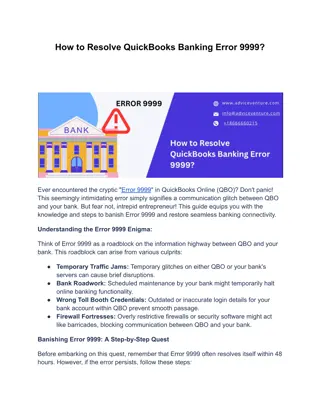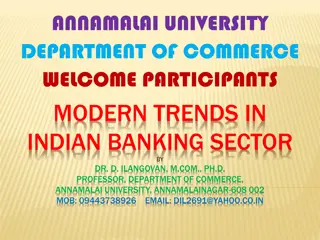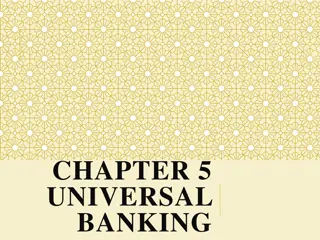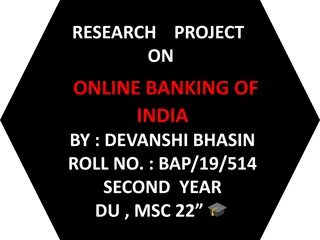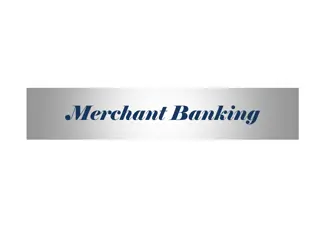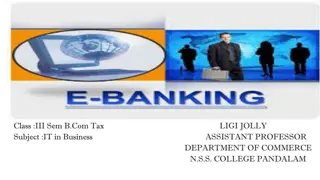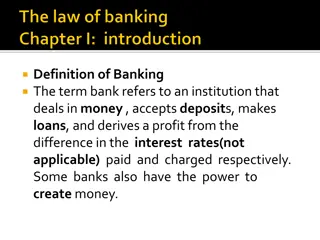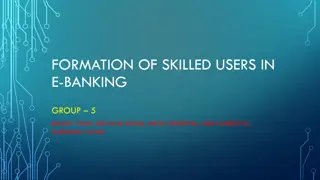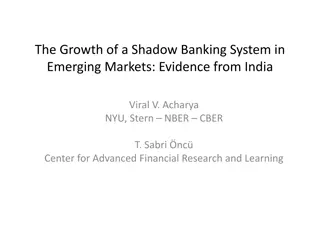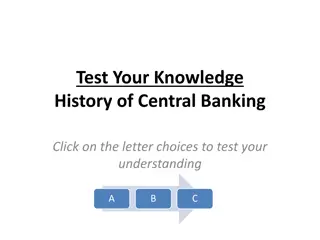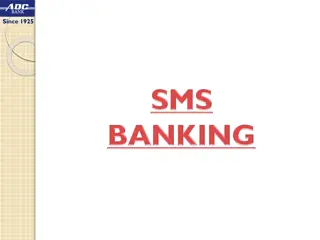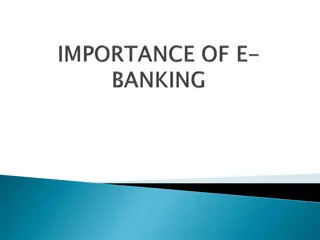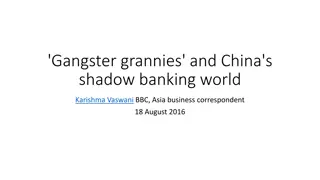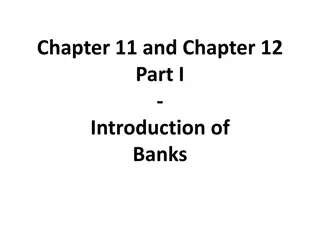Technology in Banking
Explore how technology in banking has transformed services through e-banking, offering convenience with features like 24/7 access, fund transfers, and virtual banking options. Discover electronic delivery channels like ATMs, smart cards, and internet banking.
Download Presentation

Please find below an Image/Link to download the presentation.
The content on the website is provided AS IS for your information and personal use only. It may not be sold, licensed, or shared on other websites without obtaining consent from the author.If you encounter any issues during the download, it is possible that the publisher has removed the file from their server.
You are allowed to download the files provided on this website for personal or commercial use, subject to the condition that they are used lawfully. All files are the property of their respective owners.
The content on the website is provided AS IS for your information and personal use only. It may not be sold, licensed, or shared on other websites without obtaining consent from the author.
E N D
Presentation Transcript
Technology in Banking CHAPTER 6 CHAPTER 6
INTRODUCTION The information technology has revolutionized various aspects of human life. Internet is an interconnection of computer communication network covering the whole world. The growth and expansion of internet and information technology have facilitated the emergence of E-commerce. E-commerce refers to carrying of business including banking. Hence, electronic banking (e banking) implies performing basic banking transactions by customers through electronic media. In 1983 and 1988 committees were formed under the Chairmanship of the Deputy Governor on business transactions electronically; it covers any form RBI Dr.C,Rangarajan regarding possibilities and stages involved in bank computerization and bank mechanism respectively. The four objectives of computerization in banking customer services (ii) home keeping (iii) decision making and (iv) productivity and profitability.
MEANING With the introduction and implementation or technology in banking, electronic devices are payments of cash and non-cash payments easy and efficient. The introduction of ATMS and the plastic cards has given the banking customers the facility of round-the-clock i.e. 24 hours banking Today's banking is virtual banking. Virtual banking denotes the provision of banking and other related services through the extensive use of IT, without direct resource to the bank by customers. The principle type of virtual banking services include ATM, Shared ATM networks, Electronic Fund Transfer at point of Sale (EFTPOS), Smart cards, stored value cards, phone banking, home banking, internet and intranet bank. Thus, the practice of banking has undergone a transformation due to the adoption of E-banking. E-banking provides the following products and services to customers: 1) View, print or save account statement. 2) View the details of deposit. 3) Transfer of fund to other account. 4) More than one account of same customer can be linked 5) Make loan payment. 6) Submit a change of address request. 7) Place an order for cheque book. 8) Submit a stop payment request.
FEATURES OF E-BANKING: (1) 24 hours banking is possible now-a-days. E-banking allows24x7 access to all customers to check account balances and transactions and also customer can monitor incoming and outgoing payments. (2) Online banking is possible multiple geographies, in real-time through a single log-on. (3) E-banking provides the facility of fund transfer from one account to another without visiting the bricks of the bank branch office. (4) Corporate banking and personal banking from home (ie.home banking) is possible through E-banking. The basic requirement for that is internet connection. (5) Electronic banking delivery channels are ATM, smart cards. Mobile banking, telebanking and internet banking. (6) E-banking is more of a science than an art. (7) Customer can find all account related information at one place and easily access all service requests. All payments and transfer option are available within same menu.
ELECTRONIC DELIVERY CHANNELS: The information technology has enabled banks to increase the range of their products and also market them more effectively. The popular electronic delivery channels are: (1)ATMS. (2)Smart Cards. (3)Telebanking. (4)Internet banking. (5)Mobile banking.
(1) ATMS: The introduction of Automated Teller Machines (ATMS) has given facility to the customers for banking beyond the banking hours. An ATM is a device located in or off the bank's premises to receive and dispense cash round the clock. Customers can also useATMS for depositing cash, cheque, obtaining balance, mini statement, requesting cheque book, payment of card bill and for transferring funds from one account to another. ATMS are user friendly and they have mass acceptability. They can effectively reach out a large customer base at low cost. At present banks have started outsourcing and sharing of ATM services to reduce the cost. A customer who wishes to utilize the service of ATMS will have to access to it only with an ATM card. The ATM card Consists of a Personal Identification Number (PIN) which 1s known only to the customer. At the end of March 2017, there were 109809 on site and 98545 off site ATMS in India.
ATMS for Rural Customer: (a) Biometric ATMS: ATMS are identification of the user so that even the illiterate people can use ATMS. Biometric identification is nothing but using the body password. (b)Solar Powered ATMS: It is an ATM designed to enable a low-cost model in delivering banking services in rural by using the solar energy. These ATMS are easy to use since they employ biometric system and moreover they are eco- friendly. It is cheaper and requires only one- fourth of the cost of a conventional ATM.
(c) White Label ATMS: With a view to encouraging the(e growth and penetration of ATMS, non-banking entities have been permitted to enter into the space of ATM operations. ATMS opened under such categories white label ATMS. More than 15 non-banking entities have been granted approval to launch white label ATMS. Non-bank entity with a minimum net worth of Rs. 100 crore, can apply for white label ATM. In 2012, RBI framed guidelines for white labels and in 2013, has given the license for white label ATMs. Tata communication payment solutions Ltd. was the first company who installed white label ATM. Muthoot Finance, Srei Infra, Prizm Payments are the examples of white label ATM. (d) Brown Label ATMS: Brown label ATM are those ATMS where hardware and the lease of the ATM machine is owned by a service provider, but cash management and connectivity of banking network is provided by a Sponsor bank whose brand is used on the ATM. The brown label ATM has come up as an alternation between banks owned ATMS and white label ATMS.
Raj sbi card Using Sbi atm : red label If using Indian bank atm : BROWN LABEL IF USING (NBFC) MUTHOOT FIN CORP ATM: WHITE LABEL BIO METRICS: GREEN LABEL
(2) Smart Cards: The smart cards technology is also widely used by bankers to market their products. Smart card which is a chip-based card it is kind of an electronic purse. When a transaction is made using the card, the value is debited and the balance comes down automatically. Once the monetary value comes down to nil, the balance is to be restored all over again so that the card becomes operational as usual. It is mere safer than ATM, Debit card and Credit card. It provides communication security as it verifies whether the signature is genuine or not. The card also recognizes different voices and compares with the recorded original voice. A smart card in size and shape is like normal credit card but its inside is altogether different. There is embedded microprocessor inside. As compared to the magnetic strip technology the microprocessor on the smart card provides added security.
(3) Telebanking Telebanking is increasingly used as a delivery channel for marketing banking services. A customer can do entire non-cash related banking over the phone anywhere and any time. Automatic Voice Recorders (AVR) or ID Number is used for rendering telebanking services.
(4) Internet banking: Many banks have their own website. The bank services can be accessed through website of the bank. The launch of security First Network Bank (SFNB)was on 18th October, 1995 in the USA as the first virtual bank. It marks as turning point in the development of internet banking. Internet banking is the ability to use one's personal computer or laptop to communicate with one's bank. The bank should get approval from RBI before providing internet services to customers. The customers are able to open current and savings account through online. Following are the advantages of internet banking: Anywhere and anytime banking service. Worldwide connectivity. Easy access of recent and historical date. Direct customer control on movement of funds. Greater processing speed and accuracy.
(5) Mobile banking: Today, mobile communication technologies offer vast additional value for consumers banking transactions due to their always-on functionally and the option to access banks anytime and anywhere. Biggest limitation of Internet banking is the requirement of a personal computer/laptop with an internet connection but mobile banking addresses this fundamental limitation of internet banking, as it reduces the customer requirement which is only one mobile phone. The main reason that mobile banking scores over internet banking is that it enables 'Anywhere Anytime Banking'. Presently, mobile banking is being deployed using mobile applications developed on one of the following formed channels: (i) IVR (Interactive Voice Responses) (ii) SMS (Short Message Service) (iii)WAP (Wireless Access Protocol) (iv) Standalone Mobile Application Client
ADVANTAGES OF E-BANKING: 1) 24x7: E-banking facilitates performing of basic banking transactions by customers round the clock globally. Worldwide 24 hours and seven days a week banking services are possible. 2) Convenience: Customers can perform basic banking transactions by simply sitting at their office or at home. E- banking increases the customer's convenience. 3) Low cost: The operational costs have come down due to technology adoption. The cost of transactions through internet banking is much less than any other transactional mode. 4) Customer satisfaction: The increased speed of response to customer requirements under E-banking can enhance customer satisfaction.
(5) Profitable Banking: E-banking leads to higher profits via handling a large number of customer accounts and it can also offer various products to the existing customers without any additional cost. (6) Time reduced/saved: Before this, customers used to stand in a queue in the bank, which is now reduced or avoided because of e-banking. Hence customers time is saved, same way, bank employee's time is also saved. (7) Service banking: E-banking creates strong basic infrastructure for the banks to embark upon many cash management products and to venture in the new field. Instant credit, immediate payment of utility bills, instant transfer of funds, etc. would be made possible under E-banking.
CONSTRAINTS IN E-BANKING: (1) Startup cost: Many banks have expressed their connection about the huge initial start-up cost for venturing into E-banking. Cost includes network, modem, bridges, equipment etc. (2) Training and maintenance: E-banking involves 24 hour support environment, quality service so end-users and other partner which would necessitate well qualified people. Hence the bank has to spend a lot on training. (3) Lack of skilled personnel: It is a well-known fact that there is an acute scarcity of web developers, content providers and knowledgeable professionals. The obsolescence of technology is fast. Hence, there is always a shortage of skilled personnel. (4) Security: Providing appropriate security may require major initial investments in the form application, encryption techniques, and implementation of firewalls. (5) Restricted Business: Not all transactions can be carried out electronically. For some purposes, the customer has to go to the bank.
PAYMENT AND SETTLEMENT SYSTEM: A well-functioning payment and settlement system is crucial for the successful implementation of monetary policy and maintaining the financial stability. In India, the development of a safe, secure and sound payment and settlement system has been the key policy objectives. In this direction, the RBI, apart from performing the regulatory and supervisory functions, has also been making efforts to promote functionality and modernization of the payment and settlement systems on an on- going basis. A safe and efficient payment system is a prerequisite for smooth functioning of the financial markets. The conduct of monetary policy in an effective manner require safe and efficient payment and settlement systems to facilitate transfer of funds and securities between the central bank and other participants in the financial system.
Segment of Payment System: Payment system in India comprises electronic payment system as well as paper based systems. Another classification pertains to large value payment systems and retail payment system. PAYMENT SYSTEM LARGE VALUE PAYMENT SYSTEM RETAIL PAYMENT SYSTEM HIGH VALUE CLEARING (PAPER BASED CLEARING) PAPER BASED SYSTEM(MICR/NON- MICR CHEQUE) ELECTRONIC PAYMENT EFT, NEFT, ECS RTGS CCIL
(1) Large Value Payment System: (a) Real Time Gross Settlement (RTGS) System: In India RTGS system was operational in March 2004. The system started operations with four banks and settled only inter-bank transactions. Subsequently, the system was opened for settlement of multilateral net settlement batch (MNSB) files from September 2006.RIGS system is owned and operated by RBI. The membership of RTGS is open to all scheduled commercial banks, Primary Dealer (PD) and others, as may be decided by the RBI. The settlement of RTGS transactions takes place in the books of the RBI. For this Purpose, members have to open a RTGS Settlement Account' with the RBI at Mumbai. The Indian RTGS has adopted with FIFO (First In First Out) rule for queuing to execute the transaction. Members are provided with collateralized intraday liquidity (IDL) facility to tide over their IDL mismatches. Minimum amount transfer through RTGS is Rs. 2 lakh. RTGS operations are governed by the RTGS Membership Regulations, 2004 and RTGS (Membership) Business Operating Guidelines, 2006
Advantages of RTGS: (i) Certainty of Payment: All payment under RTGS is irrevocable and final. So, beneficiary account can be credited immediately. (ii) Faster collection of funds: The RTGS would provide an opportunity to collect funds at a faster rate due to improved technology. It has the effect of reducing the receiver's working capital cycle. (iii) No settlement risk: It reduces settlement risk since credit to an account is final with no possibility of subsequent returns. (iv) Improved liquidity Management: From bank's point of view, the liquidity management can be improved. (v) Better Inventory Management: Faster funds transfers facilitate better inventory and supply chain management.
(b) High Value Clearing: This is a paper based clearing for large value payments. This clearing is held at 27 majorities. Cheques of Rs. 1 lakh and above and payable locally are exchanged by banks during a time slot of half an hour (12 noon to 12.30 pm) and unpaid returns, if any, are exchanged during 3 to 3.30 pm, completing the clearing process on the same day. The multilateral net settlement position is settled in the settlement bank by4.30pm. The beneficiary's account is credited on the same day, withdrawal is permitted on the same day in branches with extended working house and with AT facilities.
(c) The Clearing Corporation of India (CCIL): CCIL was setup with the prime objective to improve efficiency in the transaction settlement process. It provides end to end technology solution for efficient trading, clearing and settlement in Glits, Forex and other related product. The funds leg of the CCIL operated clearing system covering government securities, foreign exchange and money market settle in the RTGS system. It operates the largest clearing and settlement services in India in terms of value.
Retail Payment System: The retail payment system in India Consists of the paper-based clearing systems, electronic clearing systems, etc.(a) Paper based system: Cheques as payment instruments are the m0st popular mode of non-cash payment in India. As on May 31, 2014 there were 1396 operational clearinghouses. Of these, at 66 countries, the clearing and settlement processes have been automated by the introduction of MICR technology based sorter machines. The clearing and settlement cycle is completed in two days.(b) Electronic Payment Instrument: The retail electronic payment system in India are NEFT and ECS: Electronic Fund Transfer (EFT): The EFT system was introduced in the mid 1990s. EFT facilitates transfer of fund from one bank account to another. This system is now progressively being replaced with the NEFT. National Electronic Fund Transfer (NEFT): The NEFT is an electronic message based payment system and was introduced by the RBI in Nov. 2005to replace EFT system. NEFT is more secure nation-side retail electronic payment system to facilitate fund transfer by the bank customers, between the networked bank branches in the country. The service charge to be levied by banks for the transactions. After demonetization, number of transaction through NEFT has been increased. (iii) Electronic Clearing Services (ECS): ECS is a retail payment system which facilitates bulk payment that can be classified as one-to-many and receipts that are many-to-one. The two components of this system are ECS (Credit and ECS Debit). ECS (Credit) facilitates the bulk payments whereby the account of the institution remitting the payment is debited and the payments remitted to beneficiaries' accounts. ECS (Debit) facilitates the collection of by utility companies. In this system the account of the customer of the utility company indifferent banks are debited and the amounts are payments transferred to the account of the utility company. (i) (ii)
IMPORTANT TERMS IN BANKING TECHNOLOGY: 1 ) POS Terminal: A Point Of Sale (POS) Terminal is an electronic device used to process card payments at retail locations. A POS terminal generally does the following: I. reads the information of customer debit card or credit card; II. checks whether the customer have sufficient funds in the account or not; III. transfer the funds to the seller account from custom account; IV. records the transaction; and V. prints the receipt. At the end of March 2017, there were 2526342 online and 2799 off line POS in India.
(2) IMPS: Immediate Payment Services (IMPS) is an instant interbank electronic fund transfer service through mobile phones. It is also being extended through other channels such as ATM, Internet Banking, etc. It offers an instant 24 x 7 interbank electronic fund service. It is a multichannel and multi-dimensional platform that makes the payments possible within a fraction of seconds with althea standards and integrity maintained for security required for even high worth transactions. While transferring funds person to person (P2P), mobile number and MMID (Mobile Money Identification Number) having 7 digits are used. Next, while sending funds from person to account (P2A), bank account number and IFS code are used. Funds can be transferred by using Aadhaar Number (ABRS) in this case, Aadhaar number acts as financial address and which will be linked to the beneficiaries account number.
(3) NUUP: National Unified USSD Platform (NUUP) is a USSD based mobile banking service provided by National Payment Corporation of India (NPCI) that brings together all the banks and Telecom Service providers in India. USSD means Unstructured Supplementary Service Data. In this, customer don't need to have internet, can access banking services by just pressing *99# from his/her mobile phone. This service helps to do the following transaction: Balance enquiry. Fund transfer (using mobile no. and MMID) Change MPIN. Mini statement. General OTP for IMPS Merchant Payment. Some banks don't charge for non-financial transaction. This service is available round the clock. Currently SBI charges the following service charges for fund transfer through IMPS:
(4) AEPS: AEPS provides the following services: 1. Balance Enquiry. 2. Cash withdrawal. 3. Cash deposit. 4. Aadhaar to Aadhaar Fund transfer Objectives of AEPS: (i) To empower a bank customer to use Aadhaar as his/her identity to access his/her respective Aadhaar enabled bank account and perform basic banking transactions. (ii) To improve financial inclusion. (iii) To increase the utilization of online payment for retail payment. (iv) To facilitate disbursements of Government entitlement like social security pension, handicapped pension, etc. of Central or State Government bodies, using Aadhaar and authentication there of as supported by UIDAI (Unique Identification Authority of India). (v) To build the foundation for a full range of Aadhaar enabled Banking Services.
(5) APBS:APBS stands for Aadhaar Payment Bridge System. It is unique payment system implemented by National Payment Corporation of India (NPCI), which uses Aadhaar Number as central key for electronically channelizing the Government subsidies and benefits in the Aadhaar enabled bank accounts for the intended beneficiaries. APB system is used by the Government Department and Agencies for the transfer of benefit and subsidies under Direct Benefit Transfer (DBT) scheme launched by Government of India. Following are the benefits of APB 1. Eliminating unnecessary delays, multiple channel and paper work involved in the existing system. 2. This is mostly for Government use for disbursement of benefits, subsidies. Example LPG subsidy, Pension, etc. 3. Transfer benefits and subsidies in time and directly into the Aadhaar Enabled Bank Account. 4. In case of change in bank account, customer is not required to inform the bank account details to Government Department/Agency. 5. Customers are not required to open multiple bank account for receiving benefits and subsidies of various social welfare schemes.
(6) Core Banking Solution (CBS): It is a centralized branch computerization model in which branches are connected to a central host. In core banking, there is a central database for the bank and transactions are done centrally and online. There is a scope for induction of modern banking services and one single software for all the branches and is operated on the bank's WAN infrastructure. It enables customers to operate their accounts and avail banking services from any branch of the bank on CBS network, regardless of where to maintain his account. All CBS branches are inter-connected with each other. Therefore, customers of CBS branches can avail various banking facilities from any other CBS branch locatedanywhere in the world.
(7) CTS: CTS stand for Cheque Truncation System. Cheque truncation means a cheque which is truncated during the course of cycle either by the clearing house or by the bank whether paying or receiving payment, immediately on generation of animate for transmission, substituting the further physical movement of the cheque in writing. Truncation of cheque can be done using either the MICR data or image processing software. It speeds up the process of collection of cheques resulting in better services to customers, reduces the scope of loss of instrument in transit, lowers the cost of collection of cheques and removes reconciliation and logistics related problems. CTS have been implemented in New Delhi, Chennai and Mumbai with effect from 2008, 2011 and 2013 respectively. After migration of the entire cheque volume from MICR System to CTS, the traditional MICR based cheque processing has been discontinued across the city.
(8) Digital Signature: Digital Signature is the new concept brought under the ambit of legislation in India with the enactment of Information Technology Act 2000. It comprehensively addresses the legal issues concerning the electronic messaging and electronic payment system. Digital signature is not the replica of manual signature captured through a scanner or otherwise. Digit signature is the key and must be applied in a manner to satisfy the following critical features: i. Authenticity: The validity of the source of the electronic message should be ascertained through digital signature by verifying the sources or the originator of the message. ii. Integrity: Integrity of a message transmitted electronically is of paramount importance. The message has to received intact and should not have been altered in anyway during the transmission.
(9) M-wallet: The mobile wallet, which is also called m-wallet, digital wallet, refers to a mobile technology that is used similarly to a real wallet. A mobile wallet is a type of payment service through which business organization and individuals can receive and send money via mobile devices. It is a form of a commerce model that is designed to be used with mobile devices due to their convenience and easy access. A mobile wallet primarily enables an individual to pay as well as receive payment using a mobile device. This includes: (i) Mobile based billing: A user generally sends/receives payment via their mobile service provider. (ii) SMS-based transaction: The transaction is initiated by sending a SMS short code. (iii) Mobile payments: Allows a user to send/receive payments via a mobile app. Regardless of the model used, a mobile wallet service is generally delivered by and in collaboration with mobile service providers and banks or other financial institutions. Some of the mobile app based wallets are: Airtel Money. mRupee. Jio Money. Axis Bank lime. Mobikwik. ICICI Pockets. FT cash .Oxigen wallet. Freecharge. Paytm, etc.
ONLINE ACCOUNT OPENING PROCESS: (a) Saving Bank Account/Current Account: The person who wants to open a saving account through online has to go through three simple steps namely, filling form sprinting the form and attaching the documents. Finally it has to be submitted to the nearest bank branch with the required documents. It is discussed in details as follows: Step 1:This section will be filled by the person who wants to open the account. First, the person has to fill part A, once the part A is filled, the system will generate Temporary Customer Reference Number (TCRN). TCRN will be sent to the registered mobile number of the applicants also. This TCRN is used by the applicant if he/she wants to edit the form. Step 2:After the first part, details about type of account and servicesrequired have to be filled. Nomination form is also filled here, this is optional one but recommended by bank to fill the nomination form. Once you have filled, save the form, a Temporary Account Reference Number (TARN) will be generated which the applicant needs it later for editing or printing the form. After completion of Step 2 also, SMS will be sent to the applicant along with TARN number. Step 3:Clients are instructed to read the rules carefully before signing the account opening form. By applying to the bank for opening the account, applicant would be confirming that applicant have read the rules and regulations that the applicant agrees to abide by this. After this, print the form and submit to the nearest bank branch office along with the documents.
Documents required: 2 recent passport size colored photographs. KYC documents as mentioned in the AOF. Form 60, if applicant do not have PAN of income tax. Form DA-1 (optional) if applicant wishes to make a nomination. Under KYC, one Identity and address proof each from PAN card, passport, voter identity card, driving license, Aadhaar card, etc. are required. b) Online application for credit card: Most of the banks follow very simple steps to apply for credit card. SBI have very simple steps to apply for a credit card. There are three steps as under: Step 1: First step is to select the type of card. SBI banks provide different type of credit cards with different features and schemes. The applicant has to select the card first. Step 2: Next step is filling basic details including name, is address, income details, PAN, email id and mobile number. Immediately the mobile number will be verified through OTP. Once the mobile number is verified, the customer has to accept the terms and conditions of the bank. Step 3: Submit the saved application. Further, the applicant will be contacted by the bank officials.
c) Online application for loan: Online personal, cash loans, short term and even housing loans Can be applied by the client of the banks. Banks provide online application form, which is very simple to fill. The client has to fill the form and before filling the form, the client has to check the following: I. Eligibility. II. EMI calculation. III. Service charges and fees. IV. Documentation. After these steps, the client has to fill the information containing the details of personal, income and loan. For example, if a client of ICICI bank wants to apply for personal loan online, it can be done through any one of the following ways: (i) Online process without login: Log in to www.icicibank.com main page click on products- loans select personal loan - request a call. (ii) Internet banking: Log in to www.icicibank.com with client user ID and password main page select loans option in my accounts click on apply for loans under personal loan option click now check the eligibility and clink on Apply now. OR Log in to www.icicibank.com- main page- client can see the pre-qualified offers for personal loan -> click on instant approval. After filling the loan application forms, the client has to submit all the relevant documents along with the filled forms to the local branch of his/her account holding bank. Most of the banks, approve loan within 72 hours of document submission. Banks are providing loan for multipurpose. Loan can be payable in easy installment also.
KYC KYC means "Know Your Customer". It is a process by which banks obtain information about identify and address of the customers. The process helps to ensure that banks services are not misused. The KYC procedure is to be completed by the banks while opening the account. Banks are also required to periodically update their customers KYC details. KYC requirements for opening a bank account are submission of (1) proof of identity and (ii) address proof together with a recent photograph. The Government of India has notified six documents as "officially valid documents" (OVD) for the purpose of providing proof of identity. Passport Driving License Voter's Identity card Pan Card Aadhaar card Card issued by UIDAI and NREGA Job Card.
The applicant needs to submit any one of these documents as proof of identity. If these documents also contains customer/applicant's address details, then the same can be considered as proof of address. Otherwise he/she has to submit another document which contains address details. Without submitting any one of the above listed documents, anyone can open a bank account known as "small account" by submitting the recent photograph and putting the signature/thumb impression in the presence of the bank official. But this account has some limitations like balance of the account should not exceed Rs. 50,000, total credits in a year should not exceed Rs.1,00,000 withdrawal in a month should not exceed Rs. 10,000 and no foreign remittance to be credited in this account. If such accountholders prefer to convert into normal saving, they can convert it after 12 months from the date of opening of account by providing necessary documents. e-KYC refers to electronic KYC and it is possible only for those who have Aadhaar number. While using e-KYC services, the applicant has to authorize the Unique Identification Authority of India (UIDAI), by explicit consent, to release your address through biometric authentication to the bank branches. The UIDAI then transfers the data comprising your name, age, etc. electronically to the bank. Information thus provided through -KYC process is permitted, to be treated as an 'officially valid document' under PML Rules and is a valid process for KYC verification. KYC exercise is necessary for credit card, smart cards also. Since the debit cards are issued only to the accountholder, there is no need for separate KYC for issuing debit card.


















